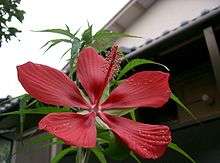Hibiscus coccineus
| Hibiscus coccineus | |
|---|---|
 | |
| Scientific classification | |
| Kingdom: | Plantae |
| (unranked): | Angiosperms |
| (unranked): | Eudicots |
| (unranked): | Rosids |
| Order: | Malvales |
| Family: | Malvaceae |
| Genus: | Hibiscus |
| Species: | H. coccineus |
| Binomial name | |
| Hibiscus coccineus (Medik.) Walter | |
Hibiscus coccineus - MHNT
Hibiscus coccineus or scarlet rosemallow,[1] is a hardy Hibiscus species that looks much like Cannabis sativa (marijuana). It is also known as Texas star, brilliant hibiscus, and scarlet hibiscus.
The plant is found in swamps, marshes and ditches on the coastal plain of the Southeastern United States. It is native from Southeastern Virginia south to Florida, then west to Louisiana. Despite its common name "Texas Star Hibiscus", the plant is not found naturally in Texas. It dies back during the winter and grows from 7-10'. In addition to the scarlet flowering variety, a white flowering variety is also known as the white Texas star or lone star hibiscus.
References
- ↑ "Hibiscus coccineus". Natural Resources Conservation Service PLANTS Database. USDA. Retrieved 1 July 2016.
| Wikimedia Commons has media related to Hibiscus coccineus. |
| Wikispecies has information related to: Hibiscus coccineus |
This article is issued from Wikipedia - version of the 11/16/2016. The text is available under the Creative Commons Attribution/Share Alike but additional terms may apply for the media files.